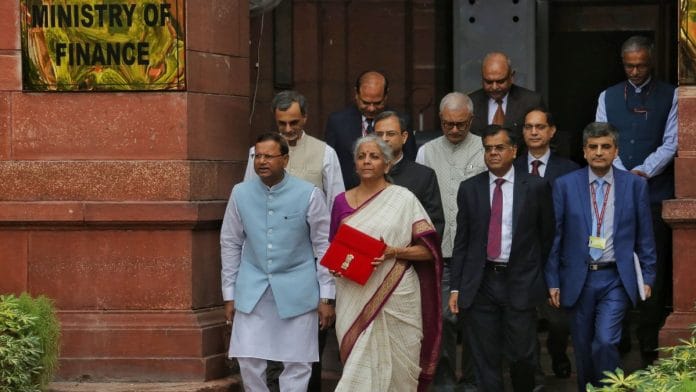Finance minister Nirmala Sitharaman’s first budget of the newly elected NDA government has struck a balance between rural spending and job creation while narrowing the fiscal deficit to 4.9 per cent of GDP for the current fiscal year.
The budget has retained spending on infrastructure at Rs 11.11 lakh crore while allocating Rs 1.5 lakh crore to states to fund capex.
This is reasonable, as with eight months left for the year, it will be difficult to raise spending beyond the initially budgeted figure.
Education, employment, skilling, and MSMEs
Many data sources have pointed to the job deficit in the country. The budget has announced a series of measures to address this, making a provision of Rs 1.48 lakh crore for education, employment, and skilling.
Three incentive schemes have been announced, which will benefit first-time job seekers, promote job creation in manufacturing, and offer support to employers. The incentives will be provided in respect of employer and employee contribution to EPFO (except for first-timers, who will receive a direct benefit transfer).
This will likely give a fillip to job creation in the formal sector. In addition, a centrally sponsored scheme for the skilling of youth and concessional loans for higher education will support quality employment generation. This will also be beneficial from the viewpoint of supporting consumption.
The finance minister has announced various measures to bolster the micro, small, and medium enterprises (MSMEs), particularly in labour-intensive manufacturing. A credit guarantee scheme will provide term loans for the purchase of machinery and equipment without collateral. It will involve a self-financing guarantee fund.
To further enhance the flow of credit, the limit for Mudra loans under the Tarun category has been increased from Rs 10 lakh to Rs 20 lakh. Credit support during stress periods and reduction of the onboarding threshold for the TreDS platform will bolster MSMEs.
Also read: Modi govt’s Budget 2024 plays unabashed appeasement politics—after borrowing Congress ideas
Fiscal consolidation
The target for fiscal deficit has been lowered to 4.9 per cent of GDP, compared to the earlier figure of 5.1 in the interim budget. The target signals the government’s intention to remain steadfast on the path of fiscal prudence despite expectations of higher spending. The larger-than-anticipated dividend received from the RBI has helped the government narrow its fiscal deficit target.
As compared to the interim budget, the target for revenue deficit has also been lowered from 2 per cent of GDP to 1.8. The lower borrowing target should cheer the bond market and boost foreign investment in sovereign debt. However, the government has stopped short of announcing its medium-term deficit and debt trajectory beyond FY26.
Income tax relief to support consumption
Given the weakness in consumption and elevated inflation, the budget was expected to provide a cushion to the individual taxpayer. Some comfort has been provided to taxpayers who opt for the new tax regime.
The raising of the standard deduction limit alongside some rationalisation across tax slabs will stimulate spending. However, there is no change in the tax liability for the old tax regime.
Also read: Economic Survey 2023-24—India’s path toward Viksit Bharat goes through geopolitical challenges
Capital gains tax
Since the Covid-19 pandemic in 2020, there has been a surge in retail investor participation in stock markets, inducing a record rally. The data on household savings on financial assets shows that since Covid, the share of bank deposits has gradually gone down while the share of equity and mutual funds has increased.
This is likely to see a hit after the announcement of a hike in tax rates on equity investments. Capital gains on equity investments held for less than one year will now be taxed at 20 per cent in place of the previous 15. In the case of investments held for more than one year, this tax has been raised from 10 per cent to 12.5.
The budget has also raised the Security Transactions Tax on derivatives. While these decisions may have been taken in view of concerns around overheating flagged by regulators and the Economic Survey, they will hurt investor sentiment.
Over the past several years, there has been stability in the capital gains framework. While the tax increase is marginal, the announcement could deter investors from investing in the stock market. There could be a shift of household savings towards bank deposits.
Also read: Modi govt’s Budget 2024 plays unabashed appeasement politics—after borrowing Congress ideas
Focus on Bihar and Andhra Pradesh
The focus on Bihar and Andhra Pradesh was expected as Janata Dal (United) and Telugu Desam Party have emerged as key allies in the NDA coalition after the BJP failed to secure a majority in the Lok Sabha elections. There were demands for granting special category status to the two states but since the practice has been discontinued, the finance minister has attempted to pacify them through substantial financial allocations.
For Andhra Pradesh, the budget announced an arrangement of Rs 15,000 crore this year, to be followed by additional amounts in the future, for the development of its capital city. It also announced assistance for irrigation projects and the development of the state’s backward regions.
For Bihar, the budget proposed an outlay of Rs 26,000 crore for various road projects. Besides, the government has also committed to setting up medical colleges, airports and sports infrastructure in the state. It is worthwhile to note that Bihar’s actual capital expenditure last year was around Rs 35,000 crore. It would be crucial to see if the state can spend the assistance provided by the government in addition to its own budgeted outlay.
Radhika Pandey is an associate professor at the National Institute of Public Finance and Policy (NIPFP). She tweets @Radhikaskp. Views are personal.
(Edited by Prasanna Bachchhav)






